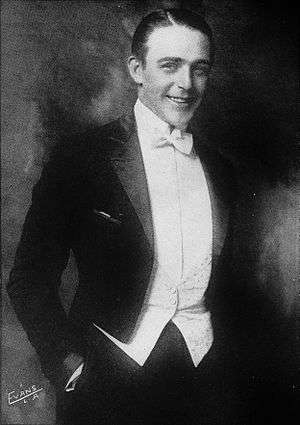Matinée idol

Matinée idol is a term used mainly to describe film or theatre stars who are adored to the point of adulation by their fans. The term almost exclusively refers to adult male actors.
Matinée idols often tend to play romantic and dramatic leading or secondary leading roles and are usually known for having good looks. The term can be taken as faintly pejorative in that it suggests the star's popularity came from the afternoon matinée performances rather than the "big picture" evenings and, hence, a less discriminating audience. Matinée idols often become the subject of parody during the height of their popularity, an example being Stan Laurel spoofing Rudolph Valentino in his film Mud and Sand.
Now a somewhat old-fashioned term, the phenomenon reached its height from the 1920s to around the 1960s in Hollywood. "Teen idol" is a similar term which more often refers to youthful musicians rather than film actors. The term differs from "sex symbol," which refers to a star's sexual attractiveness in and outside of film more so than their romantic performances on the screen. A sex symbol, however, may also be a matinée idol.
Famous Matinée Idols

1910s-1920s
Matinée idols during this time were commonly referred to simply as "lovers." "Latin Lovers," actors or actors who specialized in characters of Latin American or Romance European descent, became popular in the 1920s after Rudolph Valentino's famous performance as Julio Desnoyers in The Four Horsemen of the Apocalypse. Other Latin Lovers include Ramon Novarro, Antonio Moreno, and Ricardo Cortez.[4]
- Harold Lockwood
- Sessue Hayakawa
- Antonio Moreno[5]
- Wallace Reid[5]
- Richard Barthelmess[5][2][3]
- Thomas Meighan[5][6]
- Richard Dix[5][7]
- Douglas Fairbanks[5]
- Ramon Novarro[5][7][8]
- Rudolph Valentino[5][8][9][6]
- Ivor Novello[8][9]
- Reginald Denny[5]
- Adolphe Menjou[7]
- John Gilbert[7]
- Ronald Colman[7]
- Francis X. Bushman
- Ricardo Cortez[6]
- Charles de Rochefort[6]
1930s
1940s
1950s
Sports
- Professional boxer Bobby Czyz, who fought and lost to Evander Holyfield, Mustafa Hamsho, and Virgil Hill, was nicknamed "The Matinee Idol".
- During the November 15, 2009, Sunday Night Football game between the New England Patriots and the Indianapolis Colts, Bob Costas used the term to describe New England Patriot's quarterback Tom Brady. The Colts went on to win by a score of 35-34.[11]
- Professional boxer Oscar "Golden Boy" De La Hoya is also another fighter known as "Matinee Idol".
References

- ↑ (1918). "Favorite Picture Players" Picture-Play Magazine
- 1 2 "The Shadow Stage". Photoplay. New York: Photoplay Publishing Company. February 1922. Retrieved September 3, 2015.
- 1 2 G. C. (1921). "What the Fans Think" Picture-Play Magazine
- ↑ "The Plot of Today". Motion Picture Magazine. New York: Brewster Publications. March 1924. Retrieved September 5, 2015.
- 1 2 3 4 5 6 7 8 9 St. Johns, Adela Rogers (April 1924). "What Kind of Men Attract Women Most?". Photoplay. New York: Photoplay Publishing Company. Retrieved September 3, 2015.
- 1 2 3 4 Underhill, Hariette (January 1925). "Men I Love". Photoplay. New York: Photoplay Publishing Company. Retrieved September 4, 2015.
- 1 2 3 4 5 Smith, Anges (July 1926). "Have They Got It?". Photoplay. New York: Photoplay Publishing Company. Retrieved September 3, 2015.
- 1 2 3 Williams p.12-15
- 1 2 3 4 Chesterfield, Winston (February 16, 2008). "Unmistakable Style of Matinee Idol". Men's Flair. Men's Flair. Retrieved September 3, 2015.
- ↑ Barry, Michael Thomas (August 25, 2011). "Van Johnson, Paul Muni". Official Blog of Author and Columnist Michael Thomas Barry. Blogspot. Retrieved September 3, 2015.
- ↑ Colts.com
Bibliography
- Williams, Michael. Ivor Novello: Screen Idol. BFI, 2003.